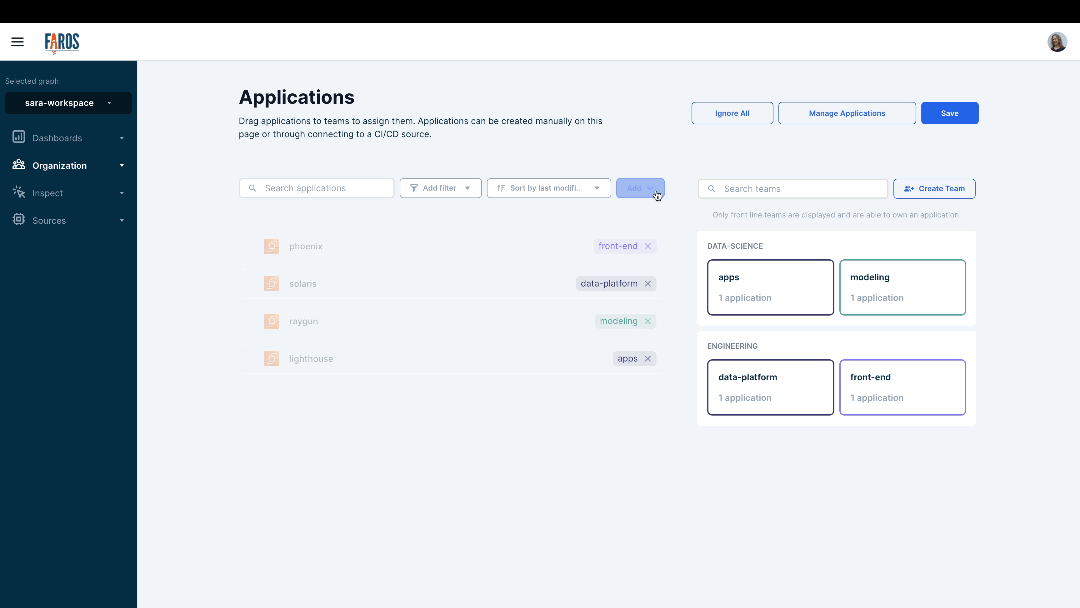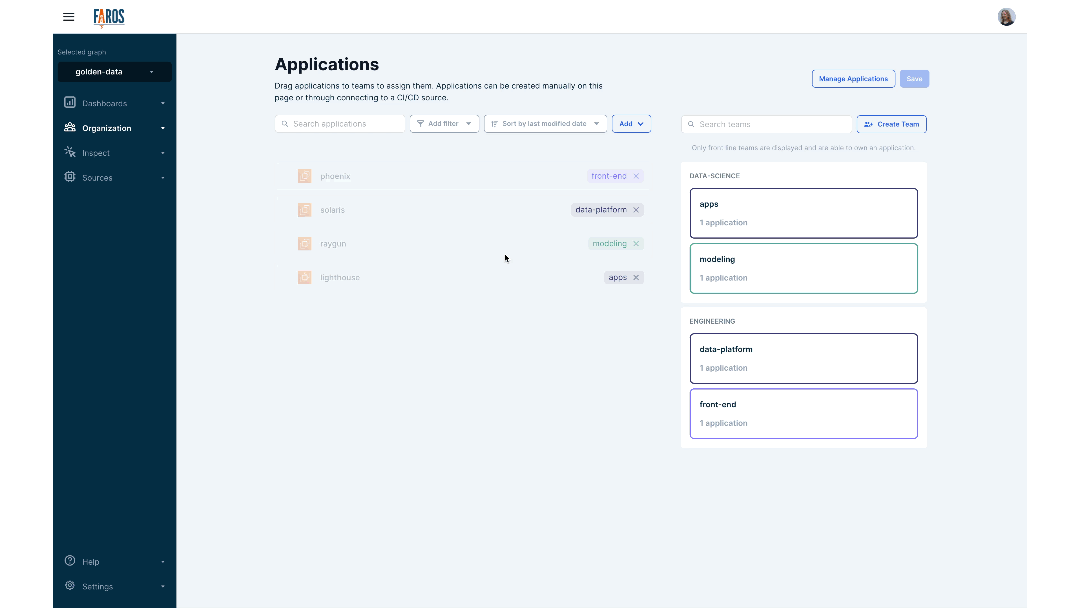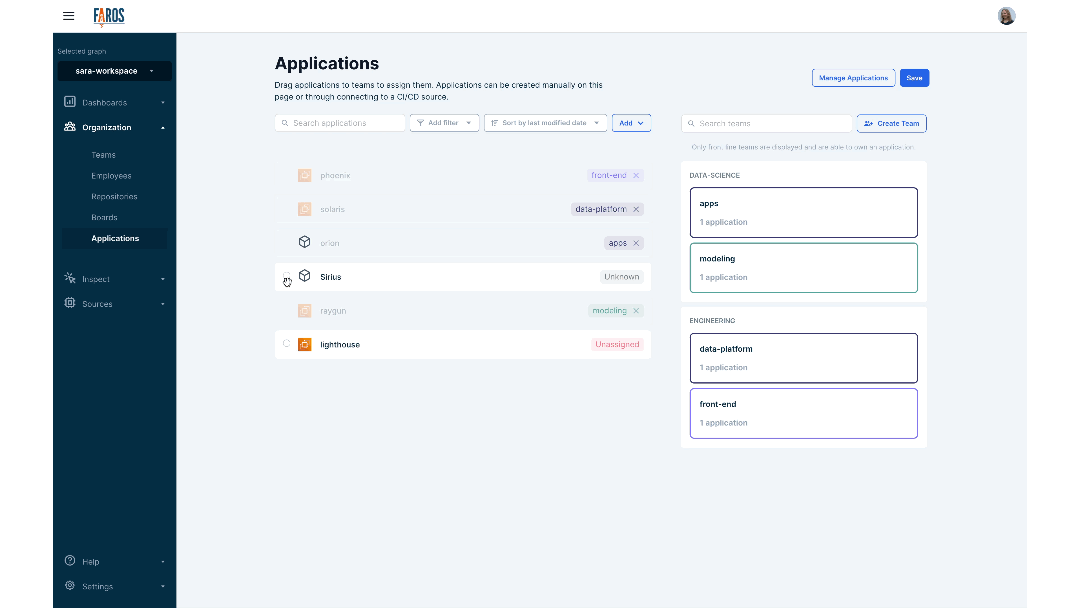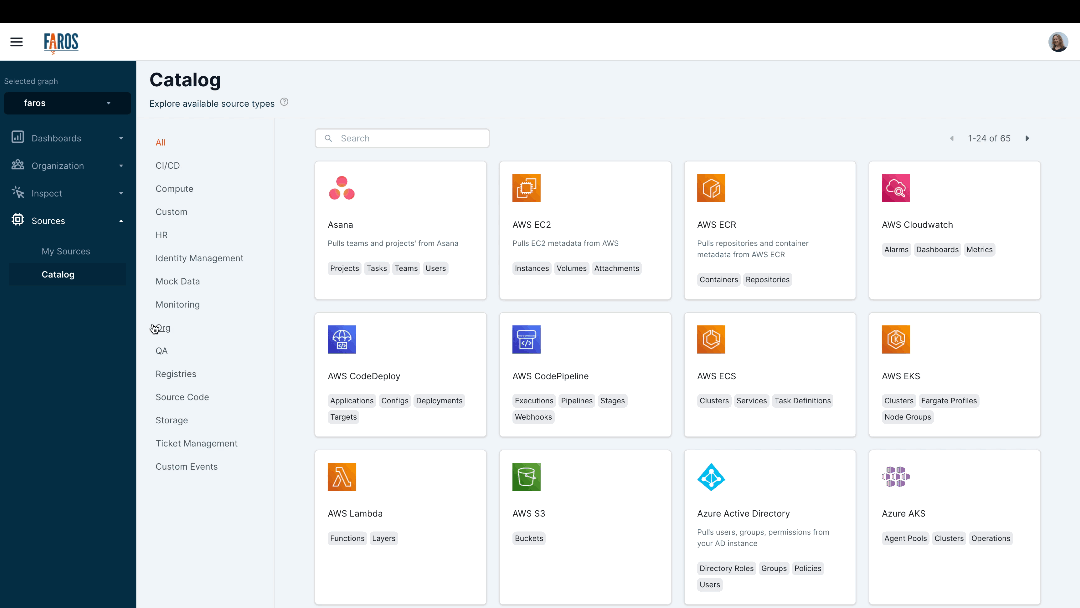Managing Apps, Repos and Boards
Repositories, boards and applications are tracked as part of your organizational structure.
Repositories: Faros repositories reflect the repositories from your version control system (VCS), and are automatically populated via your VCS source.
Boards: Faros boards reflect the boards or projects from your task management system (TMS), and are automatically populated via your TMS source.
Applications: An application is a unit of deployment for which you want to track DORA and other metrics. An application might be a service, a library, or a collection of services. Applications in Faros can be created in a multiple of ways. You can create them manually via the UI or dynamically via specified sources or events.
A Note about Pipelines
Pipelines are another object that can be managed just like boards, repositories and applications. However, unlike the other objects, pipeline inclusion and team ownership is not used in any of the out of the box dashboards.
You can create custom charts that leverage pipeline ownership such as charts around the number of builds or the breakdown of build statuses per pipeline owned by a given team. For these insights you will want to follow the steps below to assign pipelines to a team
Creating New Applications
Using the UI to manually create applications
You can create applications manually via the UI as in the video below.
Manual changes take effect on the next sync; re-sync the source and graph manually if you want to see the changes right away.

Dynamically creating applications via monitoring sources
The following sources will automatically generate applications. When configuring the below sources, you have the option to map services and components in the source to the application in Faros.
| Source | Setup Parameter |
|---|---|
| PagerDuty | PagerDuty service-to-application mapping |
| StatusPage | Statuspage component-to-application mapping |
| VictorOps | VictorOps service-to-application mapping |
Dynamically creating applications via continuous deployment events
Applications are dynamically created based on the attributes in a CD event. When you post a CD event, you define the application name. Faros will assign the event to an existing application or create a new application if needed. See Integration with CI/CD systems for integration steps.
Applications, Repositories, and Boards Status
Applications, Repositories and boards have the same statuses: Unknown, Ignored, or Included.
-
Included: These are the boards and repositories that you would like us to track in your Faros instance. Data for this object will automatically added to the
Unassignedteam unless it is assigned to a specific team. Some sources, including Jira and Github, rely on objects being included before finer grained data like PRs and Tickets are pulled into Faros. -
Ignored: These are the boards, applications and repositories that you would like us to ignore and not keep track within your Faros instance. When we refresh data from the underlying source, we will not pull data from those boards or repositories while they are in the ignored state, and no data will be available in the dashboards or the reporting database. This board or repository will remain ignored unless you manually change the status in the UI.
-
Unknown: If you do not use either the org inference or include the objects manually via the UI, the objects will be in the unknown state. By default, the data from unknown boards, repositories, and applications is not pulled from sources.
Moving objects between Ignored and Included
To change the status of an application, repository, or board, use the "Manage Application" option in the upper right hand corner of the page.
Changes take effect on the next sync; re-sync the source and graph manually if you want to see the changes right away.

Team Assignments
Application, repositories and boards can be associated with teams. Having these connections well defined will allow for easier querying and report creation. If these objects do not have teams, this will be reflected in the dashboards; all data not associated with a team that is not explicitly ignored goes into the Unassigned team.
There are two ways to create these associations, manually via the UI or automatically.
Using the UI to manually create associations with teams
You have the option to drag and drop your boards, repositories or applications onto teams in UI. Changes take effect on the next sync; re-sync the source and graph manually if you want to see the changes right away.

Using the “Ownership Inference” Source to let Faros create associations
The “ownership inference” source is available in the source catalog under the “Org” category, and it allows Faros to automatically assign boards, repos and/or applications to teams based on the employees that created, completed, or reviewed the associated tasks or commits/PRs. Changes take effect on the next sync; re-sync the source and graph manually if you want to see the changes right away.

Once your employees, applications, repositories, and boards are associated with teams, sources and graphs are synced, you are ready to fully use the standard Faros dashboards. You can also start to create your own team-based dashboards and charts. For more details, please see Faros Attribution Model.
Updated 5 months ago
